present participle phrase คือ: นี่คือโพสต์ที่เกี่ยวข้องกับหัวข้อนี้
Participles หมายถึง คำกริยาที่ใช้เป็นคุณศัพท์ขยายนาม โดย
เติม – ing แสดงว่านามนั้นเป็นผู้กระทำกริยา หรือ
เติม – ed แสดงว่านามนั้นเป็นผู้ถูกกระทำ
-ed กับ -ing ต่างกันอย่างไร
มาดูความหมาย วิธีใช้ และตัวอย่างประโยคกันครับ
Table of Contents
การเติม -ed
use to describe how people feel
ใช้สำหรับบรรยายความรู้สึกของคน
bored = (รู้สึก) เบื่อ
interested = (รู้สึก) สนใจ
excited = (รู้สึก) ตื่นเต้น
confused = (รู้สึก) สับสน
surprised = (รู้สึก) แปลกใจ
frustrated = (รู้สึก) ท้อแท้
ตัวอย่างประโยคภาษาอังกฤษ
Jimmy had nothing to do. He was very bored.
จิมมี่ไม่มีอะไรทำ เขาเบื่อมาก
การเติม -ing
use to describe something that causes an emotion
ใช้สำหรับอธิบายบางสิ่งที่เป็นสาเหตุให้เกิดอารมณ์ความรู้สึกนั้น
boring = น่าเบื่อ
interesting = น่าสนใจ
exciting = น่าตื่นเต้น
confusing = น่าสับสน
surprising = น่าแปลกใจ
frustrating = น่าท้อแท้, น่าผิดหวัง
ตัวอย่างประโยคภาษาอังกฤษ
The movie was interesting. I want to watch it again.
หนังเรื่องนั้นน่าสนใจ ฉันอยากดูอีก
Present Participles
กริยาที่เติม – ing โดยวางอยู่หน้าคำนาม แสดงว่าเป็นผู้
กระทำกริยานั้น และเป็นวลีที่ใช้รวมประโยค Simple Sentence 2 ประโยคเข้าเป็นประโยคเดียวกันได้
ตำแหน่งและหน้าที่ของ Present Participles
1. วางอยู่หน้าคำนาม จะเป็นดังรูป V.ing + noun
Mary is a working woman.
2. เป็นวลีอยู่หน้าคำอื่นๆ ดังรูป V.ing + word or words ซึ่งประโยค Simple Sentence 2 ประโยคที่มีประธานเป็นคนเดียวกันมารวมกันเป็นประโยคเดียวกัน โดยตัดประธานอีกตัวทิ้ง กริยาที่เกิดก่อนทำเป็น V.ing
Seeing her father, Mary ran away.
มาจาก Mary saw her father. และ Mary ran away.
Past Participles
Past Participles คือกริยาช่องที่ 3 ที่วางไว้หน้าคำนามเพื่อแสดงว่านามนั้นเป็นผู้ถูกกระทำ และเป็นวลีที่ใช้รวมประโยค Simple Sentence 2 ประโยคเข้าเป็นประโยคเดียวกัน
ตำแหน่งและหน้าที่ของ Past Participles
1. วางอยู่หน้าคำนาม (V3 + noun) หรือ หลังคำนาม (noun + V3) เมื่อเป็น transitive verb ( กริยาที่ต้องมี
กรรมมารับ) หรือ วางไว้หน้าคำนามที่เดียวเท่านั้น เมื่อเป็น intransitive verb ( กริยาที่ไม่ต้องมีกรรมมารับ) ตัวอย่างเช่น
transitive verb :
The car which was stolen last week is mine.
จะได้ The car stolen last week is mine.
The stolen car last week is mine.
intransitive verb :
Please change the flowers which were faded in the living room.
จะได้ Please change the faded flowers in the living room.
2. วางอยู่หลัง verb to be จะเป็น passive voice (is, am, are, was, were + V.3) เช่น
John was punished by his teacher.
3. เป็นวลีที่อยู่หน้าคำอื่น ๆ (V.3 + word or words) โดยรวมประโยค Simple Sentence 2 ประโยคเข้าด้วยกันเป็นประโยคเดียว โดยตัดประธานออก 1 ตัว กริยาที่เกิดก่อนทำเป็น V.3 เช่น
He was punished by his teacher. He cried loudly.
Punished by his teacher, he cried loudly.
4. Past Participle ใช้ Adverb ขยายได้ (Adv. + past participle + noun) เช่น
a well-designed dress
การรวมประโยค Simple Sentence
1. เมื่อประธานเป็นตัวเดียวกัน มีหลักดังนี้
– ถ้าประธานเป็น noun และ pronoun ให้ตัดประธานที่เป็น pronoun ทิ้ง
– ถ้ากริยาที่เกิดขึ้นก่อนเป็น active form และเป็น past simple tense ให้เปลี่ยนกริยาเป็น present participle ( V-ing) เช่น
He believed in her story. He gave her hundred baht.
Believing in her story, he gave her hundred baht.
– ถ้ากริยาที่เกิดขึ้นก่อนเป็น passive form อยู่ในรูป Verb to be + V3 ให้ตัด Verb to be ออกให้เหลือ V3 (past participle) หรือใช้ being + V3 เช่น
She was arrested by the police. She was sent to the prison.
Arrested by the police, she was sent to the prison.
Being arrested by the police, she was sent to the prison.
– ถ้ากริยาที่เกิดขึ้นก่อนเป็น active form และเป็น past perfect tense คืออยู่ในรูป had + V3 ให้เปลี่ยน had เป็น having หรือตัด had ทิ้งแล้วเปลี่ยน V3 เป็น V-ing
He had worked hard all week. He felt tried.
Having worked hard all week, he felt tried.
Working hard all week, he felt tried.
2. เมื่อประธานไม่ใช่ตัวเดียวกัน มีหลักดังนี้
– ไม่ตัดประธานของทั้ง 2 ประโยคออก
– ถ้ากริยาที่เกิดก่อนเป็น Active form อยู่ในรูป past simple tense ให้เปลี่ยนกริยาเป็น (had + V3) และเปลี่ยน had ให้เป็น having เช่น
She walked in the park. A dog bit her.
She having walked in the park, a dog bit her.
– ถ้ากริยาที่เกิดก่อนเป็น Passive form ( verb to be + V.3)ให้เปลี่ยน เป็น had been + V.3 แล้วเปลี่ยน had เป็น having
She was taken to hospital. The doctor examined her.
She having been taken to hospital, the doctor examined her.
– ถ้ากริยาที่เกิดก่อนเป็น Active form อยู่ในรูป had + V.3 ให้เปลี่ยน had เป็น having
He had worked for five days. His job was finally finished.
He having worked for five days, his job was finally finished.
เรียนเรื่อง participle อย่างละเอียด ได้ที่
![]() Participle คืออะไร
Participle คืออะไร
[NEW] วลีภาษาอังกฤษ (Phrase) | present participle phrase คือ – NATAVIGUIDES
วลี (Phrase) คือ กลุ่มคำ (a group of words) ที่ไม่มีกิริยาแท้ (Finite Verbs)
การที่จะศึกษาเรื่องวลี (Phrase) ให้เข้าใจถ่องแท้นั้น นักศึกษาควรรับทราบเรื่องของกิริยา (Verb) ในแง่หนึ่งให้เข้าใจเสียก่อนว่า ถ้าเราแบ่งกิริยา (Verb) ตามรูปแบบ (Form) จะได้เป็น 2 ประเภท คือ
1. กิริยาแท้ (Finite Verbs)
2. กิริยาไม่แท้ (Non-finite Verb)
กิริยาแท้ (Finite Verbs) หมายถึง กิริยา (Verb) ที่เปลี่ยนรูปร่าง (Forms) ให้สัมพันธ์กับประธาน (Subject) ของประโยค เช่น
I am a boy.
I eat rice.
You are a boy.
He eats rice.
He is a boy.
They eat rice.
จากตัวอย่างข้างต้น จะพบว่า คำกิริยา (Verb) ทุกคำในประโยคเป็นกิริยาแท้ (Finite Verb) ทั้งสิ้นเพราะยอมเปลี่ยนรูปร่างให้สัมพันธ์กับประธาน (Subject) ของประโยคอยู่เสมอ
กริยาไม่แท้ (Non-finite Verbs) คือ กิริยาที่ไม่ยอมเปลี่ยนรูปร่างให้สัมพันธ์กับประธาน (Subject) ของประโยคเลย
เช่น
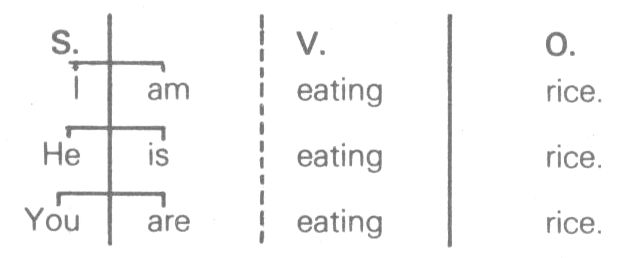
จะพบว่าส่วนของกิริยา (Verb) ประกอบด้วย 2 คำ หรือที่เรียกกิริยารูปผสม (Compound Verb) แต่กิริยา (Verb) ที่อยู่ใกล้ประธาน (Subject) ของประโยคจะยอมเปลี่ยนรูปร่างตามประธาน จึงเป็นกิริยาแท้ (Finite Verb) ส่วนกิริยาที่อยู่ไกลประธานออกไป จะไม่ยอมเปลี่ยนรูปร่างตามประธานเลย จึงเรียกว่า กิริยาไม่แท้ (Non-finite Verb)
จงสังเกตตัวอย่างต่อไปนี้อีกครั้งหนึ่ง

จาก 2 ตัวอย่างข้างบนพอจะสรุปได้ว่า ประโยคเอกกัตถประโยค (Simple Sentence) ทุกประโยคจะมีกิริยาแท้ (Finite Verb) เพียงตัวเดียวเท่านั้น ส่วนกิริยาไม่แท้ (Non-finite Verb) นั้นสามารกมีได้มากกว่า 2 ตัวขึ้นไป และรูปร่าง (Form) ของกิริยาไม่แท้ (Non- finite Verbs) นั้นไม่มีการเปลี่ยนรูป (Unchanged) เลย
ดังนั้น รูป (Form) ของกิริยาไม่แท้ (Non-finite Verb) จึงแน่นอนตายตัว ซึ่งแบ่งออกได้เป็น 3 รูป ด้งนี้:-
1. Infinitive (V. หรือ To+V1)
2. Participle (V-ing หรือ V3)
3. Gerund (V-ing)
ฉะนั้น รูปวลี (Forms of Phrases) จะประกอบด้วยกิริยาไม่แท้ (Non-finite Verbs) เป็นหลัก ซึ่งนักภาษาศาสตร์ได้รวบรวมจากการที่พบเห็นบุคคลทั่วไปนิยมใช้ไว้ 6 รูป ดังนี้
1. Infinitive Phrase (วลีที่ประกอบด้วยรูป Infinitive เป็นหลัก) ซึ่งนำไปใช้ใน 3 หน้าที่ดังนี้
1.1 ทำหน้าที่เหมือนคำนาม (Noun) เช่น
1.1.1 เป็นประธาน (Subject) ของประโยค เช่น
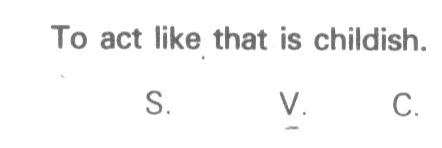
1.1.2 เป็นกรรมตรง (Direct Object) ของกิริยา เช่น

1.1.3 .เป็นส่วนสมบูรณ์ของประธาน (Subjective Complement) เช่น

นอกจากนี้ยังใช้เป็นส่วนสมบูรณ์ของกรรม (Objective Complement) เช่น

1.2 ทำหน้าที่เหมือนคำคุณศัพท์ (Adjective) คือ ใช้ขยายคำนาม (Noun) หรือขยายสรรพนามไม่ชี้เฉพาะ (Indefinite Pronoun) เช่น
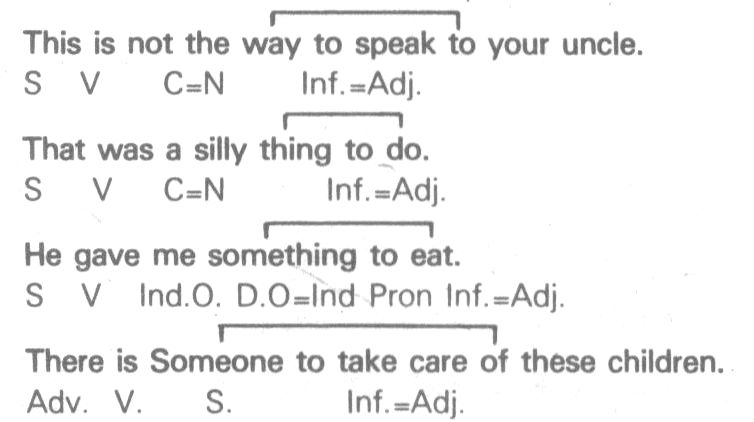
1.3 ทำหน้าที่เหมือนคำกิริยาวิเศษณ์ (Adverb) คือ ใช้ขยายคำกิริยา (Verb) ขยายคำคุณศัพท์ (Adjective) หรือขยายคำกิริยาวิเศษณ์ (Adverb) อีกคำหนึ่ง เช่น
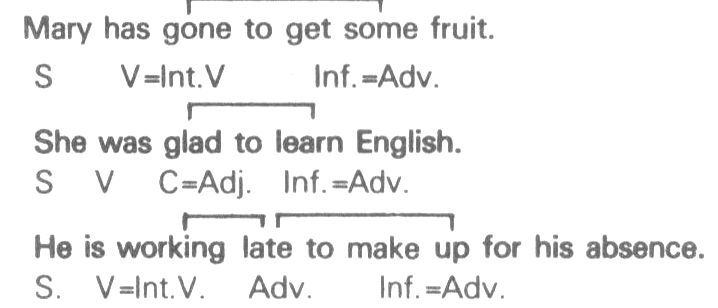
อนึ่ง ยังมีการใช้ Infinitive Phrase ในหน้าที่ Adverb อีกลักษณะหนึ่งซึ่งพบเห็นในงานเขียนทั่วไป คือ การใช้ในความหมายเน้น (Emphasis) จะวาง Infinitive Phrase ไว้หน้าประโยค ซึ่งลักษณะเช่นว่านี้ใช้ในภาษาเขียนเท่านั้น เช่น
![]()
หมายเหตุ การใช้ Infinitive Phrase ในลักษณะเช่นนี้ ต้องสังเกตให้ดีว่าประธาน (subject) ของประโยคจะต้องสัมพันธ์กับ Infinitive เสมอหรือจะต้องกระทำอาการ Infinitive นั้นด้วย มิฉะนั้นจะถือว่าผิดไวยากรณ์ ซึ่งเรียกความผิดชนิดนี้ว่า “Dangling Infinitive” หรือ
“Misrelated Infinitive” เช่น
“Misrelated Infinitive” เช่น
![]()
อนึ่ง มีกลุ่ม Infinitive Phrase ต่อไปนี้
To tell you the truth,………………………………………………
To hear him talk…………………………………………………..
To cut a long story short…………………………………………
To continue with what I was saying,……………………………
สามารถนำไปวางไว้หน้าประโยคทุกประโยค โดยไม่เกิดความผิด Dangling Infinitive เลย เพราะกลุ่มวลีเหล่านี้มีความหมายกว้างๆ ไม่ เจาะจงประธานของประโยคตัวใดเลย
2. Participial Phrase (วลีที่ประกอบด้วย Participle เป็นหลัก) แบ่งออกเป็น 2 รูป ดังนี้:-
1. Present Participial Phrase (V-ing)
2. Past Participial Phrase (V3)
ก่อนที่จะศึกษาการใช้ Participial Phrase ขอให้จดจำความหมายที่แฝงอยู่ใน Phrase ทั้ง 2 รูปนี้ก่อนว่า Present Par¬ticipial Phrase นั้นจะมีความหมายเป็น Active (แสดงการกระทำกิริยา) และ Past Participial Phrase จะมีความหมายเป็น Passive (ถูกกระทำโดยกิริยา) ซึ่งมีหน้าที่ 2 ประการ ดังนี้
2.1 ทำหน้าที่เหมือนคุณศัพท์ (Adjective) คือ ใช้ขยายคำนาม (Noun) เช่น

2.2 ทำหน้าที่เหมือนกิริยาวิเศษณ์ (Adverb 1/2) คือ ใช้ขยายกิริยา (Verb) ขยายคุณศัพท์ (Adjective) และขยายกิริยาวิเศษณ์
(Adverb) อีกคำหนึ่ง เช่น

ข้อสังเกต การใช้ Participial Phrase ในหน้าที่ Adverb นั้น จะมีลักษณะเหมือนกับการใช้ Infinitive Phrase ในหน้าที่ Adverb เช่นกัน
คือ ใช้วางไว้ข้างหน้าประโยคและใช้ในภาษาเขียนเท่านั้น และต้องระวังที่จะต้องให้ประธาน (Subject) ของประโยคสัมพันธ์หรือกระทำอาการ Participle ด้วย มิฉะนั้นจะถือว่าผิดไวยากรณ์ในความผิดที่ว่า “Dangling Participle” หรือ mis-related Participle เช่น ![]()
หมายเหตุ นอกจากจะวาง Participial Phrase ในหน้าที่ Adverb ไว้หน้าประโยคแล้ว มีนักเขียนบางท่านวางไว้หลังประโยค หรือบางทีกลางประโยคก็มี
อนึ่ง มีกลุ่ม Participial Phrase บางกลุ่ม ซึ่งสามารถนำไปวางไว้หน้าประโยคทุกประโยคโดยไม่เกิดความผิด Dangling Participle เลย เพราะมีความหมายกว้างๆ ไม่ชี้เฉพาะเจาะจงประธานของประโยคตัวใด เช่น
Generally speaking………………………………………………..
Talking of football…………………………………………………..
Considering the position as a whole ……………………………..
Roughly speaking,…………………………………………………
Allowing for extras,…………………………………………………
Strictly speaking……………………………………………………
3. Gerundial Phrase (วลีที่ประกอบด้วยรูป Gerund เป็นหลัก) ซึ่งมีหน้าที่ในประโยคเพียงประการเดียวเท่านั้น คือ ทำหน้าที่เหมือนคำนาม (Noun) เช่น
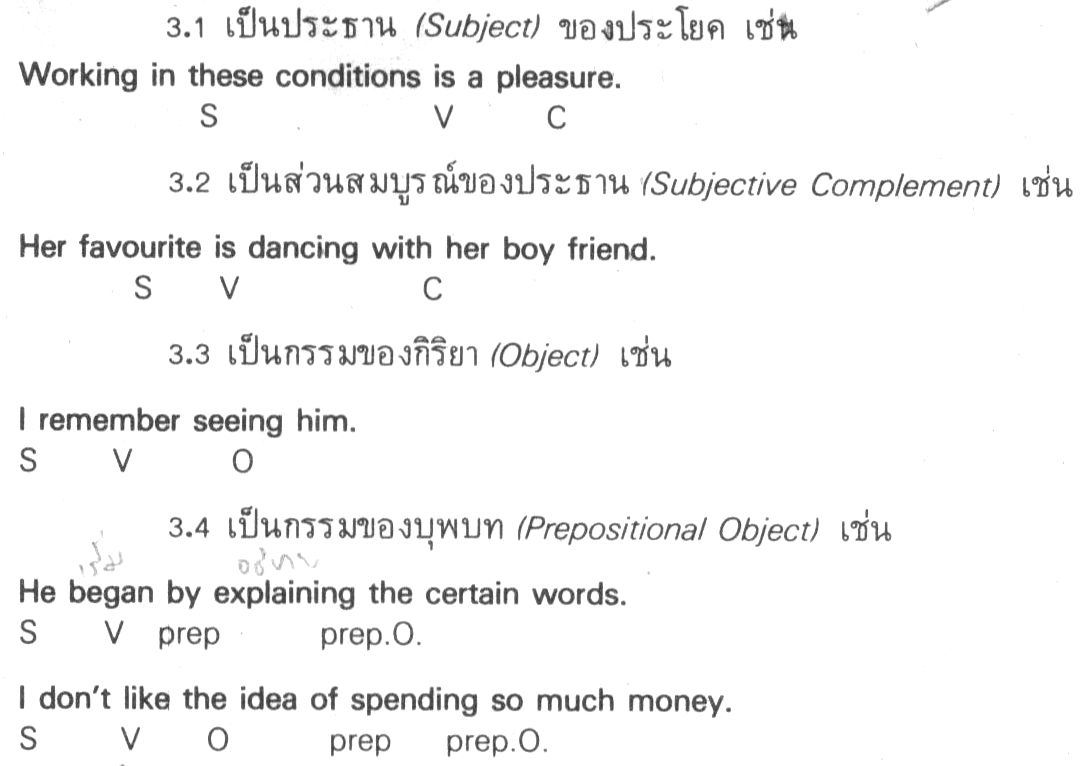
4. Prepositional Phrase (วลีที่ประกอบด้วยคำบุพบท (preposition) เป็นหลัก) ซึ่งทำหน้าที่ได้ 2 ประการ ดังนี้
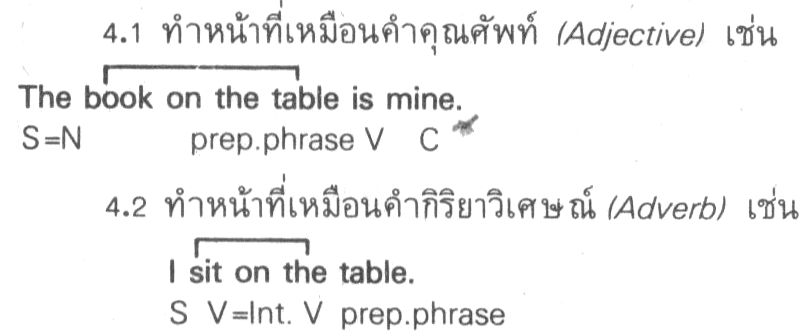
หมายเหตุ ในกรณ์ที่ใช้ Prepositional Phrase เป็น Adv. ในภาษาเขียน(Written English) อาจจะเขียนได้อีกแบบหนึ่ง และให้ความหมายเน้นกว่ารูปแบบที่เขียนดังข้างต้น นั่นคือ นำ Prepositional Phrase ไว้หน้าประโยคแล้วคั่นด้วย Comma เช่น On the table, I sit ขอให้สังเกตว่าต้องมี Comma คั่นเสมอ (นอกจากบางครั้ง Prepositional Phrase เป็นกลุ่มวลีสั้นๆ อาจจะไม่ใช้ Comma คั่นก็ได้) ถ้าไม่มี Comma คั่นระหว่างประโยค จะทำให้รูปแบบของประโยคที่ตามมาข้างหลังเปลี่ยนแปลงรูปแบบได้ นั่นคือ จะต้องใช้รูปประโยคโครงสร้างพื้นที่ทันที เช่น
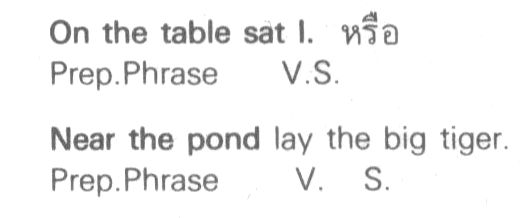
อย่างไรก็ดี ขอให้ทราบว่า รูปแบบลักษณะโครงสร้างพื้นฐานดังกล่าวนี้ มักจะใช้เขียนในหนังสือนิทานของเด็กๆ เท่านั้น
5. Absolute Phrase (วลีที่มีความหมายสมบูรณ์ในตัวเอง) เป็นวลี (phrase) ซึ่งสร้างมาจาก participial phrase นั่นเอง แต่มีประธาน (Subject) อยู่ข้างหน้าวลี สัมพันธ์กับวลีในกลุ่มของตนเอง และใช้ในหน้าที่ Adverb เท่านั้น จึงใช้นำหน้าประโยคได้ทุกประโยค โดยไม่เกิดความผิด “Dangling Participle” เช่น
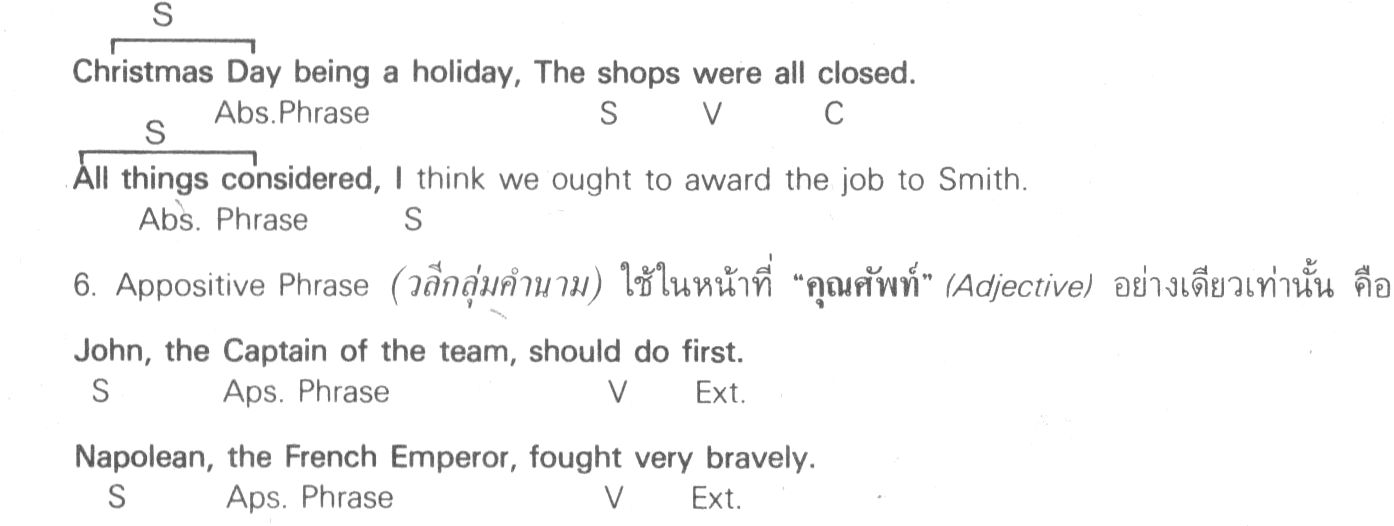
อย่างไรก็ดี มีนักไวยากรณ์บางท่านแบ่งวลี (Phrase) ไว้เพียง 3 ชนิดเท่านั้น คือ
(1) Noun Phrase (2) Adjective Phrase (3) Adverb Phrase
นั่นคือเขาแบ่งวลี (Phrase) ตามหน้าที่ (Function) ที่มันทำงานในประโยค แต่การที่เราแบ่งเป็น 6 ชนิดข้างต้นนั้น เราแบ่งตามรูป (Form)
ของมัน ซึ่งมีประโยชน์มากกว่า เพาะเราสามารถนำไปใช้งานเขียนประโยคได้
ไม่ว่าจะแบ่งวลี (Phrase) ในลักษณะใด ก็เหมือนกันทั้งสิ้น เพราะเมื่อจัดรวมกันเข้าแล้วก็เป็นลักษณะเดียวกันนั่นเอง คือ
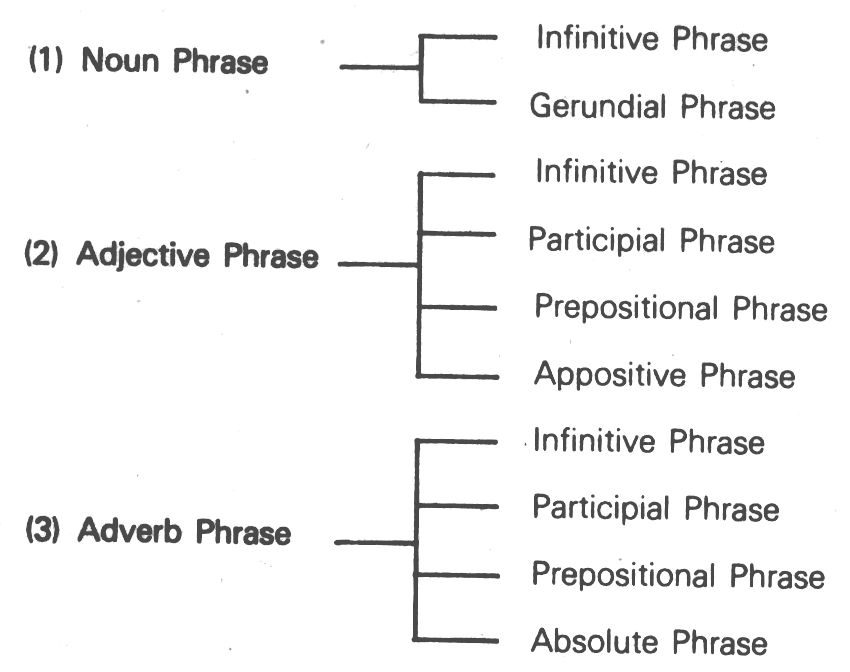
ที่มา:อาจารย์ชำนาญ ศุภนิตย์, ดร.สัญญา จัตตานนท์, อาจารย์สุทิน พูลสวัสดิ์
Advanced English Grammar: Participles
Using participles correctly will dramatically improve the quality of your English writing. If you’re learning English for university, IELTS, TOEFL, or for your career, this advanced writing lesson is for you! You will learn to analyze sentences so that you can understand them fully and write your own. Often, English learners are unsure of whether an \”ing\” word is an adjective or an adverb. In this lesson, you’ll learn how the participle \”having\” includes the subject, verb, and conjunction. I’ll show you many example sentences, and you can practice what you’ve learned on our quiz at https://www.engvid.com/advancedenglishgrammarparticiples/
TRANSCRIPT
Hi. Welcome to www.engvid.com. I’m Adam. In today’s video we’re going to look at participles. Now, this is a little bit more advanced grammar, but it’s very useful and it’s used in everyday speaking, but especially for writing and reading because you’re going to see participles everywhere. What participles do is they help you get sentence variety, they help you make your sentences shorter, if necessary, they give you a little bit of style. Okay? There are two participles that we need to look at, they are called the active or passive participle. Sometimes you’ll see them as present or past participle. Past participles, you’re familiar with. Sometimes they’re called the verb three, so: \”eat\”, past tense \”ate\”, past participle is \”eaten\”. Right? So that’s the participle. Now, especially with the \”ing\” you have to be careful because \”ing\” words, although they are verbs with \”ing\”, they can be pretty much anything. They could be a gerund, as you know, so they’re nouns; they could be part of the continuous verb, so \”be going\”, so: \”I am going\”, it’s a continuous action; but \”ing\” words can also be adjectives and adverbs. When they are adjectives and adverbs they are actually participles. So it’s very important to recognize them and know how to use them.
So what I want to do first is I want to look at the adjective participles. Now, what you have to remember about adjective participles, they are… They are reduced adjective clauses. You know an adjective clause, it’s meant to modify a noun. It identifies it or gives extra information about a noun. A participle, an adjective participle is that adjective clause minus the subject and the verb. Okay? But we’re going to look at that in a second.
So let’s look at this sentence first. Oh, sorry, let me… I made a little mistake here. \”Dressed in his classA uniform, the marine looked like a recruitment poster.\” So this is the passive or the past participle ending in \”ed\”, it’s a regular verb, so: \”dressed\”. \”Dressed in his classA uniform\”. Now, if I rearrange the sentence, really, it says: \”The marine, who was dressed in his classA uniform, looked like a recruitment poster.\” Okay? Like a poster that wants people to join the marines, etc. But I can take that adjective clause, I get rid of the \”who was\” or \”who is\”, depending on the tense. Get rid of that, and I’m left with a participle phrase. Now, I can take that participle phrase and move it to the beginning of the sentence, just like I have here. The key when you’re using participles at the beginning… A participle phrase at the beginning of a sentence, you must make sure that the subject, which is not there but it is understood: who was, who is the marine, so the marine who was dressed in his classA, and then the subject of the independent clause must be the same subject. Okay? We’re going to look at a couple more examples.
\”Standing near the window, Marie could see the entire village.\” Look at the other example: \”Standing near the window, the entire village was in view.\” Now, many people will look at both sentences and think: \”Yeah, okay, I understand them. They’re both correct.\” This sentence is incorrect. Why? Because the subject here is \”the village\”. Can the village stand near the window? No, it can’t. So: \”Standing near the window\” means Marie. \”Marie, who was standing near the window, could see the entire village.\” This subject cannot do this action, so you have to make sure that the implied or the understood subject in the participle is the exact same as the subject of the independent clause that follows it. Okay? That’s very, very important. So now what we’re going to do, I’m going to look at a few more examples and I want to show you that you can start the sentence with a participle phrase, but you can also leave it in the middle of the sentence. Okay? Let’s look at that.
Okay, let’s look at these examples now and you’ll see the different positions the participles can take. And again, we’re talking about participle phrases for the most part. \”The jazz musician, known for his tendency to daydream, got into a zone and played for an hour straight.\” Okay? So what we’re doing here, we’re giving you a little bit more information about the musician. We’re not identifying him. We’re giving you extra information, which is why we have the commas.
นอกจากการดูบทความนี้แล้ว คุณยังสามารถดูข้อมูลที่เป็นประโยชน์อื่นๆ อีกมากมายที่เราให้ไว้ที่นี่: ดูเพิ่มเติม

ติว TOEIC ครูเคน : Present \u0026 Past PARTICIPLE กริยาเทียม 2 ตัวนี้มีหน้าที่อะไรบ้าง?
【PRESENT PARTICIPLE vs PAST PARTICIPLE】คืออะไร ?
กริยาเทียมสองตัวนี้ทำอะไรได้บ้าง ดูคลิปนี้เลยครับ ครูเคนมีคำตอบให้
✦รับชีทติวสั้นฟรี!! 💬ทักแชทหาแอดมินพิมพ์โค้ด ✦ KKT009 ✦ มาที่ http://m.me/krukentoeic
✦ทดลองเรียนฟรีได้ที่ https://www.opendurian.com/toeic_kruken/
✦ คอร์สเรียน TOEIC คุณภาพ จากผู้เชี่ยวชาญตัวจริง✦
เริ่มเรียนจากพื้นฐาน สอนแบบเป็นระบบ เพื่อเพิ่มคะแนน TOEIC
KruKenTOEIC TOEIConline
TOEIConline KruKenTOEIC

เพลง Gerund

participle phrases
participles

สอนศาสตร์ : ม.ปลาย : ภาษาอังกฤษ : Pharse ทำหน้าที่เป็น Noun/Adjective/Adverb
รายการสอนศาสตร์ ติวฟรีถึงบ้าน โดยติวเตอร์ชั้นนำ
https://www.facebook.com/sonsart
ทรูปลูกปัญญา ทรูวิชั่นส์ 6 | ช่องความรู้ดูสนุก
หนึ่งในสิ่งดี ๆ เพื่อสังคม โดยบริษัท ทรู คอร์ปอเรชั่น จำกัด (มหาชน)
https://www.facebook.com/TrueplookpanyaChannel
http://www.trueplookpanya.com/tv

นอกจากการดูบทความนี้แล้ว คุณยังสามารถดูข้อมูลที่เป็นประโยชน์อื่นๆ อีกมากมายที่เราให้ไว้ที่นี่: ดูวิธีอื่นๆMAKE MONEY ONLINE
ขอบคุณที่รับชมกระทู้ครับ present participle phrase คือ